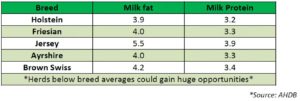Management and nutrition play an important role in how milk protein and fat are influenced, taking these into consideration to optimise payments from milk contracts is key. Seasonality and genetics also play a role, table 1 show a comparison of popular breeds.
Seasonality
Seasonality plays a significant role, mostly driven by day length and lighting. These seasonal rhythms are well conserved between breeds, with greater response seen in higher fat breeds. Therefore, even for the fully housed herd, butterfat’s are predicted to drop slightly due to this reason. For grazing herds, this is a double barrel challenge on butterfats; seasonality and diet change causing constituents to dip.
Key principles to help with seasonality:
- Review and change goals throughout the year to ensure we are not chasing “ghost” butterfat levels. This means having realistic goals and ensuring strategies are in place to meet these.
- We are not sure how to eliminate the rhythm, however, we need to mitigate anything which could increase that drop. This includes diet, management and heat stress.
Diet
- When at grass, there are increased factors that compromise milk fat production, including oil and rumen retention time. When looking at the diet, consider the rapidly fermentable carbohydrates (RFC), the acid load, fibre index and the RUFAL.
- We also want rumen health to be optimal to ensure butterfat synthesis. As previously mentioned, rumen retention time at grass is quick. The leafy feed source goes through the animal quicker than the conserved counterpart (silage). We must ensure factors are in place to maintain this retention time, ensuing enough time for the nutrients to be utilised by the animal. Supplements and appropriate diet formulation are key! *Not forgetting management*.
Fibre and rumen health is key for milk fat production whilst glucogenic nutrients are important for protein production.
Rumen pH
Ruminal pH is a determinant of microbial populations in the rumen, with low pH being a major factor leading to a change in the way butterfats are synthesised. Subtle rumen pH changes, from 6.2 to 5.8 for example, are enough for a butterfat depression to occur, causing a shift in the biohydrogenation pathway.
The rumen environment is critical, involving interactions of numerous dietary, cow and environmental factors.
Summer Management
- Turning cattle out provides farmers with the opportunity to rest housing and save on housing and labour costs.
- There is a shift in management, going from looking at cows in a housed situation, knowing exactly what they are eating and how much, to looking at cows in a field where there can be massive variabilities in forage quality and quantity, which are arguably harder to predict and manage- If we get a summer like last year, with little grass growth and warm weather, buffer feeding strategies need to be discussed and put in place.
- Do not forget about heat stress! Have you got a plan in place to ensure you can mitigate the impact?
Figure 1 shows some pointers to consider when looking to improve milk constituents:

For more information and advice on managing milk constituents or buffers & supplements, speak to your local NWF Sales Specialist or call the office on 0800 756 2787.

